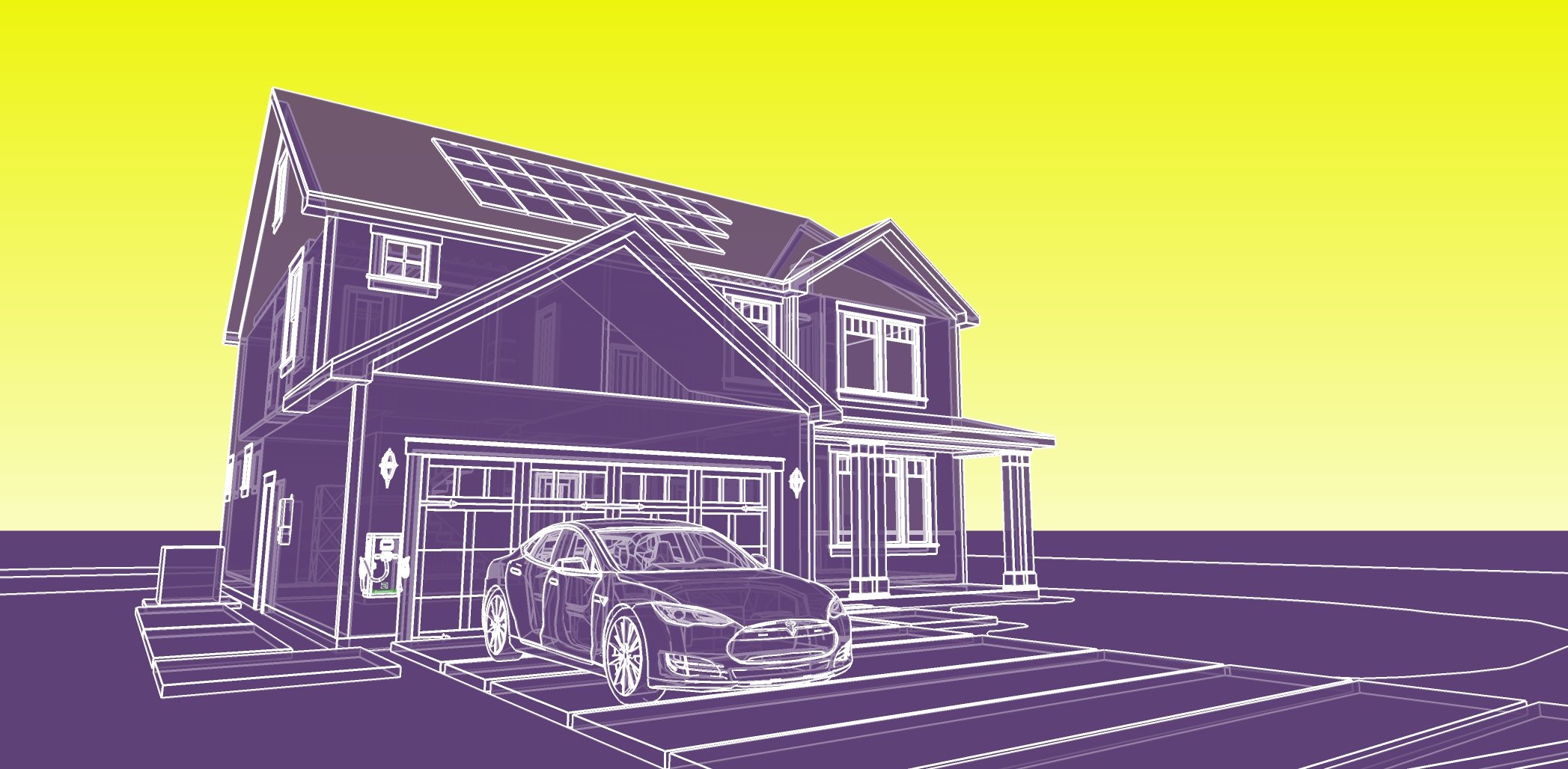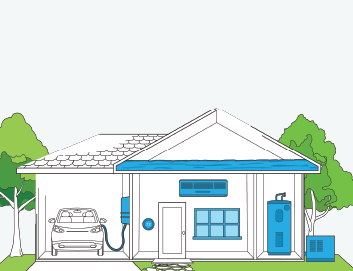connect
HOME ENERGY EFFICIENCY
HOME ELECTRICAL AUDIT
EV CHARGING CONNECTION!
SOLAR PV + BATTERY
EV CHARGING
CONNECT:
STEP 1: MAKE YOUR HOME ENERGY EFFICIENT
Advantages to owning EV include reduced vehicle operating costs and lower emissions in the air. However, having an EV will increase the electrical demand of a home. You can prepare your home by evaluating your home’s existing conditions and by looking for opportunities to reduce the home's energy demands before EV.
To make your home ready for your new EV consider performing some of the next energy efficiency measures:
LIGHTS:
A low-cost measure is to replace inefficient lighting with ENERGY STAR qualified LED lights.
APPLIANCES:
Replace aging & inefficient appliances with energy efficient ones.
SMART THERMOSTAT:
Install a programmable WiFi thermostat in your home.
INSULATION:
As per the EPA, 9 out of 10 attics are under insulated. Measure your attic's current insulation levels and add insulation where possible.
AIR-SEALING:
To reduce air-leakage in your home, caulk and weatherstrip leaky windows, doors, and baseboards.
EFFICIENT HEATING & COOLING:
The heating, ventilating & cooling (HVAC) of your home has a great impact on your home's utility bill. Consider getting an HVAC tune-up or replacing aging & inefficient equipment.
ENERGY EFFICIENCY INFORMATION-
STEP 2: HOME ELECTRICAL AUDIT
Now that you’ve looked at ways to improve the energy efficiency of your home the next step is to learn about the electrical capacity & possible needs of your home.
EXISTING HOMES
Have a Licensed Electrical Contractor (LEC) to perform an electrical load audit in your home
An electrical load audit will tell if a home has enough electrical capacity & free physical space in your Main Electrical Panel (MEP) for an EV charger
Keep in mind that in existing homes updates to your electric wiring & equipment may be necessary to add the EV load.
EV chargers can be installed indoors or outdoors. Talk to your LEC about your vehicle parking practices and the LEC will be able to help identify the best location for your future EV-charger.
NEW HOMES
Your new home can be built to be home EV-capable, EV-ready, or it can include an installed EV charger
Talk to your Builder & Licensed Electrical Contractor (LEC) during the design phase to make sure the electrical load & infrastructure are ready for your EV!
EV chargers can be installed indoors or outdoors. Talk to your Builder & LEC about your vehicle parking practices as they will be able to help identify the best location for your future EV-charger.
STEP 3: EV CHARGER CONNECTION
Now that you have taken the necessary steps to prepare your home you are ready to connect!
All electrical materials, devices, fittings, and associated equipment shall be listed or labeled and installed in accordance with our City’s current codes: National Electrical Code (2017 NEC), International Mechanical Code (2018 IMC), and Chapter 10 of the City Ordinances. Your LEC will guide you & determine what local permits are needed for the installation of your EV charger.
EV CHARGER LOCATION:
After your electrical load is completed, your LEC will inform you what is the best location for your EV charger. Some important things to discuss when choosing the location of your future EV charger are:
Future EV parking spot
Numbers of EV chargers needed
Adequate surface area of proposed location
Side of EV’s charging port
ELECTRICAL PERMITS & CRITERIA:
All electrical materials, devices, fittings, and associated equipment shall be listed or labeled and installed in accordance with our City’s current codes: National Electrical Code (2017 NEC), International Mechanical Code (2018 IMC), and Chapter 10 of the City Ordinances. Your LEC will guide you & determine what local permits are needed for the installation of your EV charger.
EV CHARGER INSTALLATION:
TIP: If you have selected or purchased a specific EV model, the EV manufacturer will recommend the best EV charger type & brand for your EV model .
LEVEL 1 CHARGER
Level 1 chargers are best for hybrid/plug-in & low mileage driving vehicles
Level 1 chargers will provide around 5 miles per each hour of charging
A Level 1 plug-in charger requires:
120 Volt 3-prong (grounded) outlet
15-20 amps circuit
If the outlet is exposed to the elements, it will need additional features such as a waterproof cover & a GFI circuit.
The recommended height for the outlet is between 35”-60” from the ground to the center of EV charger
The best horizontal distance from the wall will be determined by your LEC
LEVEL 2 CHARGER
Level 2 chargers are best for fully electric vehicles, longer commuting & faster charging.
Level 2 chargers can provide 10-30 miles per each hour of charging
A Level 2 charger (plug-in or hardwired) will need to be installed by a professional LEC
A Level 2 charger requires:
240 Volt outlet
40-60 amps of dedicated circuit
Level 2 chargers may require electrical updates in the home
The recommended height for the outlet is between 35”-60” from the ground to the center of EV charger
The best horizontal distance from the wall will be determined by your LEC
EV CHARGING BEST PRACTICES
Consider the following BEST PRACTICES when installing an EV charger & when charging your electric vehicle:
Install a Level 2 ENERGY STAR WiFi EV charger
Avoid charging your EV between 2 PM-9 PM
Consider charging your EV overnight
Identify local public EV charging stations to recharge while out and about
Participate in the CPS Energy’s FlexEV Off-Peak Rewards program

STEP 4: CHARGING YOUR EV WITH SOLAR PV BACKUP BATTERY
A great option to offset the energy demand of EV charging is to install a solar PV system in your home. Additionally, your solar PV system can be paired with a back-up battery for off peak-hours charging.
Below are the steps to consider when installing a SOLAR + BATTERY system for your EV CHARGING:
STEP A: DETERMINE HOW MUCH ENERGY your EV WILL USE
To calculate what the EV charging energy demand & cost based on your driving needs and EV preference use the below calculator from the Department of Energy. This DOE tool will let calculate your approximated annual electricity use & cost annual vehicle operating cost, cost per mile & your EV annual CO2 emissions.
To use the calculator:
Choose an EV make & model from their menu
Enter your annual vehicle usage in miles
Get your results!
STEP B: DETERMINE SIZE OF SOLAR PV SYSTEM
Now that you know your EV’s annual electricity demand use our Bring Solar Home tool to calculate the size of your solar PV system and projected cost. If you want to size your solar PV system to cover your home’s energy needs + EV charging, simply add your home’s annual electricity use.
To use the calculator:
Enter the DOE’s projected annual electricity EV use
Get your results!
STEP C: DETERMINE HOW MUCH POWER STORAGE IS NEEDED
Pairing your home’s solar PV system with a battery storage can provide the power needed to charge your EV when the sun goes down. Another great advantage of having a solar battery storage is that you can have a reliable source of electricity when the power goes out.
EV CHARGING NEEDS:
Using the estimated annual kWh of the selected EV from the DOE calculator divide the EV’s annual kWh by 365 to get a rough estimate of the daily energy EV charging demand. Keep in mind that every EV is different and the energy demand will vary depending on your EV charging needs.
If you already have an EV, a good way to calculate your EV charging energy demand is to look at past and recent utility bills. You should be able to see the difference in your monthly kWh consumption by comparing a few months pre- and post-EV driving.
Provide this information to your Solar Contractor to determine the best Solar PV size to fit your EV charging needs.
BACKUP BATTERY SIZE:
To identify the best size of your backup battery it will be necessary to determine the charging needs of your vehicle in the EV Charging Needs section. Backup batteries are available in many different sizes and the price of the battery will depend on its size; to determine which backup battery size is best for your home determine the following variables:
Type of Electric Vehicle
Type of EV charger
EV charging habits & needs
Another important step is identifying the purpose of your backup battery. It is important to decide if you want you want to offset all or only part of your EV charging electrical demand after peak-hours.
Providing this to your Solar Contractor will very helpful in finding the best backup battery type & size to fit your needs and budget!
To learn more information on all things solar & find the list of CPS Energy approved Solar Contractors visit our Bring Solar Home page.


















